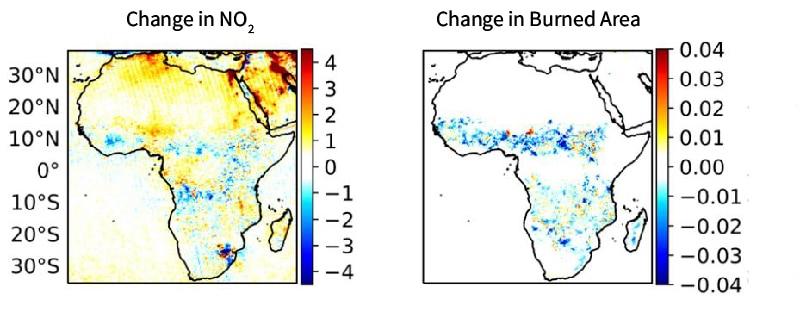Air pollution is emerging as the number cause for health concern worldwide, and the situation is often worse in developing regions, like sub-Saharan Africa. Scientists were surprised to find that nitrogen dioxide levels, a potent contributor to respiratory disease, has been decreasing over the African continent.
—
Historically, socio-economic development has come hand in hand with heightened levels of pollution. Nitrogen dioxide (NO₂) in particular enters and irritates our airways, increasing the risk of contracting or aggravating respiratory disease.
To understand the gravity of the issue, here are a few figures: air pollution from fossil fuels contributes to around 8 million premature deaths each year, (according to new research), and 9 out of 10 people are currently exposed to higher levels of pollution than considered safe under the World Health Organization’s guidelines, leading to morbidity and lowered quality of life for hundreds of millions. In Africa alone, air pollution is responsible for ~800,000 deaths a year.
The situation is usually worse in low-income countries, where haphazard development and population growth usually result in high levels of pollution. Sub-Saharan Africa has seen its fossil fuel combustion double in the last twenty years, and it is important to understand what the main contributors are if we want to do anything about it.
A team from the NASA Goddard Institute for Space Studies used satellites to measure tropospheric NO₂ levels over the African continent. Surprisingly, they found that despite the increasing wealth and population levels, nitric oxide levels had decreased.
What explains this shift from the paradigm? The researchers explain that the increased NO₂ pollution from industry and transportation was offset by a drastic decline in bushfires.

Long term trends in NO₂ and burned area in Africa between 2005 and 2017. Change in NO₂ levels in 10¹³ cm⁻³ܑ yr⁻¹, change in burned area in fraction burned yr⁻². Source: PNAS, Hickman et al. (2021). DOI: https://www.pnas.org/content/118/7/e2002579118
African farmers often burn land during the dry season as a cost-effective way to prepare it for the planting season, with the added benefit that it conserves soil nutrients. Unfortunately, this also produces serious levels of pollution that both harm human health and add greenhouse gases to the atmosphere.
The practice is so widespread that the continent is responsible for 70% of global burned area and 50% of fire-related carbon emissions. However, economic development and the conversion of savannah into cropland in the northern sub-Saharan nations has lowered the number of fires in recent years. This trend can be expected to continue over the rest of Africa and countries can use this to achieve a cleaner emission profile.
The researchers point out a caveat, which is that throughout their observations, development only lowered NO₂ levels up to a point, until high GDP levels where fossil fuel combustion counters the bushfire decline’s effect.
The importance of this study is that it fills a knowledge gap on a continent where governments prioritize growth over environmental monitoring. If these become more emphasized, information like this can be used by authorities to make better decisions regarding development.
This article was written by Owen Mulhern.
You might also like: Satellite Imagery and Post-Fire Forest Recovery










![The Statistics of Biodiversity Loss [2020 WWF Report]](https://u4d2z7k9.rocketcdn.me/wp-content/uploads/2020/12/lprwinkyTHB-544x306.jpg)





